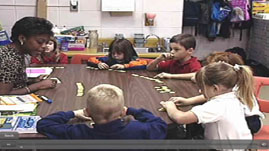Teachers' Domain - Digital Media for the Classroom and Professional Development
User: Preview




Teacher works with a small group of first-graders to build words, starting with two-letter words then building to five.
This video illustrating a phonics instructional strategy was originally part of a professional development video series, "Assessing Primary Readers," produced by KET in 2003, and also in the multimedia professional development resource Literacy Strategies in Action produced in 2006 by KET in collaboration with the Kentucky Department of Education as part of the Reading First initiative.
Phonics instruction teaches children relationships between the written word and the individual sounds of spoken language. Phonics instruction needs to be systematic and explicit. The goal is to help children understand the alphabetic principle, to be able to read and write words. The decisions when planning instruction should be based on continuous assessment data that provide evidence of what the students can and cannot do based on the developmental phonics continuum. (National Institute of Child Health and Human Development. (2000). Report of the National Reading Panel. Teaching children to read: an evidence-based assessment of the scientific research literature on reading and its implications for reading instruction. Retrieved May 5, 2011, from http://www.nichd.nih.gov/publications/nrp/smallbook.htm.)
This video presents an instructional strategy in onset-rime phonics instruction in which children learn to identify the sound of the letter or letters before the first vowel (the onset) in a one-syllable word and the sound of the remaining part of the word (the rime). Teacher Felicia Cumings-Smith guides a small group of students in "making words," starting with two-letter words and building to five.
Kentucky Department of Education: Characteristics of Highly Effective Teaching and Learning
 Loading Standards
Loading Standards